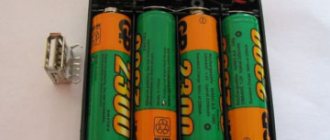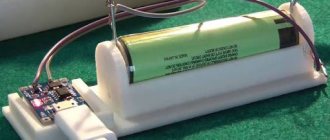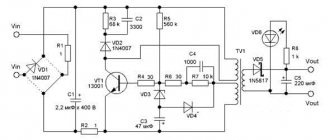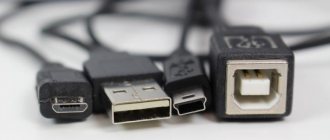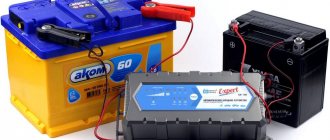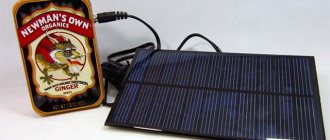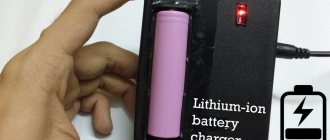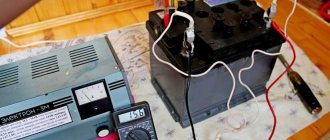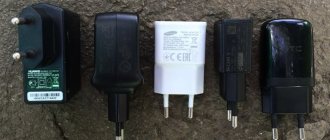Principles of charging lithium-ion batteries
The first thing to note is that a fully charged lithium battery has a nominal open circuit voltage of 3.7 volts. In this case, it must be charged to 4.2 volts. There is no contradiction here - you actually need to charge up to the specified threshold, and after charging is complete, due to self-discharge, the output level will quickly (within a few hours at most) drop to 3.7 volts. After this, the self-discharge process will slow down sharply, and the battery will stably maintain its 3.7 volts.
Unlike many types of batteries, batteries made using Li-ion technology should ideally be charged in two stages:
- charging with a stable current (to maintain it, you need to constantly increase the voltage);
- the second stage is recharging with a stable voltage (the current drops).
Professional memory devices work according to a similar algorithm.
Classic charge graph for lithium-ion batteries.
This and subsequent graphs do not indicate the preliminary stage, which is used for deeply discharged elements. Its meaning is that such a battery reaches its minimum state with a low current, and then the battery is charged as usual.
In practice, the principle of recharging the battery with current pulses of constant amplitude is often used. When a certain cell voltage level is reached (usually 4.15 volts), the charger turns off. The idle voltage of an undercharged battery quickly drops, the charger sees this and again supplies a current pulse until the threshold of 4.15 volts is reached. With each pulse, the battery is recharged, and the decline occurs more and more slowly. Also, the next and subsequent current pulses will be shorter and shorter. Due to this, pseudo-voltage stabilization is realized within certain limits. The advantage of this algorithm is that recharging is impossible in principle , and you can keep the battery in the charger for as long as you like - if it self-discharges, it will be periodically recharged.
Pulse current charging.
Another way to implement the second stage is charging with stepped current. At first glance, this algorithm is complicated.
Charging with step current.
But it can be degenerated to one stage - the voltage supplied to the element simply decreases. The charging current remains stable, although its amplitude decreases. This principle has the right to life in inexpensive chargers. The second stage takes place, in contrast to very simple chargers, in which only the first stage is implemented. Although nothing bad happens in this - the battery capacity is simply not fully used. In addition, there is a widespread but unsubstantiated statement that lithium-ion cells only need to be charged to 90%. No one has provided evidence of this; to believe it or not is everyone’s personal choice.
Charging with single-stage current.
What are PCB, BMS and PCM
Before we figure out how to properly charge lithium-ion batteries, let's understand the abbreviations PCB, BMS and PCM, which are inextricably linked with current sources of this type.
PCB
As we found out, lithium sources do not tolerate deep discharge and overcharge. In both cases, they catastrophically lose electrical capacity and fail. And if overcharged, they can even catch fire.
To monitor the condition of the battery, a PCB module - Power Control Board - is often built into it. Its task is to prevent deep discharge and overcharging of the battery.
The operating principle of such a module is quite simple. A controller placed on a small board monitors the voltage at the battery terminals. As soon as it drops below 2.8 V, the microcircuit closes the corresponding key, disconnecting the battery from the load. In this case, charging this element is allowed.
If the voltage at the terminals of the element becomes higher than 4.2 V (fully charged), the same circuit, using another key, disconnects the element from the charger, but power supply to the load is allowed. Thus, the battery can neither be recharged nor discharged to a critical value.
These protection boards are built into most lithium batteries. The only exceptions are elements intended for devices with their own battery monitoring systems. As an example, we can take a laptop battery assembled from six 18650 batteries without built-in protection.
Important! Before buying a battery, you need to find out whether it is equipped with a PCB module. If not, then you will have to monitor the condition of the element yourself. Most elements with a PCB module are marked accordingly on the case.
PCM
The PCM (Power Charge Module) is usually built not into the element, but into the device in which the element operates. For example, in a smartphone. If the PCB board only monitors the battery charge level, then the PCM unit completely controls the charging process - it provides the necessary current, controls the temperature of the element, and the voltage on it.
This is exactly the node that we call the charging controller. It is the main “controller” - it turns off charging when the battery is charged, and forcibly turns off the mobile device if the voltage on the battery is critically low. In this case, the PCB module will only be an additional protection - it almost never works. However, there are PCM modules that are only responsible for proper charging, but do not control discharge. In this case, the PCB module - built into the element or additional - is included in the work.
Expert opinion
Alexey Bartosh
Specialist in repair and maintenance of electrical equipment and industrial electronics.
Ask a Question
Important! The charging controller should not be confused with a charger (adapter) for the same smartphone. The charger is a regular five-volt power source. The battery charging process is controlled by a circuit built into the smartphone itself. The only exceptions are smart chargers designed specifically for charging lithium batteries (including those without a control module).
BMS
The BMS (Battery Monitoring System) unit can be found in batteries made up of batteries connected in series. It is, for example, in the battery of any laptop. The task of the unit is to monitor the condition of each individual battery and organize their coordinated work. Let's look at the task it performs in detail. So, we have a battery made up of four batteries connected in series.
Let's assume all cells are fully charged. The voltage on each of them is 4.2 V, on the entire battery 16.8 V. We begin discharging. The same discharge current flows through all elements, which means they are discharged equally. But this is only in theory. During operation, batteries lose capacity in different ways, that is, even with the same current, one element will discharge faster, the other more slowly. As a result, some of the batteries will already be deeply discharged, while the rest are still “pulling” and the output voltage of the entire battery seems to be normal.
The same will happen during charging. The element with the smallest capacity will charge faster and, while the others are gaining the required capacity, will overcharge and fail. The task of the BMS module is to monitor the condition of each element and take certain measures if the voltage on any of them becomes critical. If it is lower, the entire battery is disconnected from the load. If higher, then the corresponding element is disconnected from the charger while the others continue to charge.
Healthy! The BMS unit is often called a balancer, and the task it performs is called balancing. When connecting batteries in series into a battery, a balancing circuit must be present. Otherwise, the batteries will quickly fail and possibly even catch fire.
What you need for a homemade memory
First of all, you will need to select a charging scheme for 18650 cells. It is selected according to the necessary parameters, as well as the availability of parts. Secondly, the skills of reading circuit diagrams, making printed circuit boards at home (or at least ordering them from China, which is not so expensive now), soldering microcircuits and other elements, finding errors and malfunctions. If you don’t have this, you shouldn’t even read what you will need:
- radioelements according to the diagram;
- soldering iron with a set of consumables;
- board or blank for it and accessories for self-production.
You will also need a case for installing batteries for charging (it makes it more convenient to connect the battery to the charger).
Plastic case for connecting 18650 battery.
It is better to develop skills separately, and then take on the production of these devices. They are not very difficult, but require a conscious approach.
How to choose the right things to consider
When purchasing a new gadget, it is recommended to purchase the best chargers for an 18650 battery. A good charger will be the one that comes with the gadget, clearly understands how much power is needed for the battery, and stops charging in a timely manner. Original chargers first charge with a high current, and at the end of recharging they reduce the current. This prevents the element from overheating and extends its service life. If you need to buy a charger separately, you should pay attention to the basic charging functions.
Charge controller circuits
Charger for LM317.
A simple homemade memory can be assembled using the widespread and inexpensive LM317 microcircuit. In this case, it is connected according to the voltage stabilizer circuit, and the battery is charged by the falling current. This algorithm does not allow full use of the battery's capabilities, and this is the main drawback of the scheme. Another drawback is that voltages below 8 volts cannot be supplied to the circuit. Therefore, it will not be possible to power the memory from the USB port.
During the process, the current is monitored in the form of a voltage drop across resistor R1. As soon as it decreases to a certain level, transistor VT1 closes and the LED goes out, signaling the end of charging. The process does not stop, so you need to monitor the condition yourself. You can upgrade the circuit by turning on a relay instead of the LED, which, when turned off, opens the power circuit with its contacts.
The charger is somewhat more complicated, allowing you to implement a pulse current charging algorithm without any controllers.
Charger circuit with pulse recharging function.
At the first stage, the battery is charged with a stable current, the value of which is determined by the supply voltage and the value of the resistor RD. When the voltage reaches the threshold of 4.15 volts, the comparator is triggered and transistor VT1 is turned off. The voltage across the element will soon drop below the threshold, and the transistor will open again. This procedure will continue cyclically, but as the charge progresses, the pauses will become longer and the pulses shorter. As a result, the battery will be charged to a voltage of 4.15 volts, which is set by resistor R1.
Analysis of the circuit shows that it can be easily simplified without reducing functionality. So, instead of a transformer with a midpoint and a rectifier, you can take any power source with a voltage of 5 volts (there is no need to increase the voltage much, the elements of the power circuit will heat up, bringing the thermal death of the universe closer). The transistor can be replaced with a bipolar one (the domestic KT827 is also suitable).
Simplified memory diagram.
The voltage detector can be replaced with KIA742, KIA719, KIA739. As a result, the diagram will take the following form.
You can also use specialized microcircuits specifically designed to create such chargers. One of them is MCP73831.
Charging algorithm implemented on the MCP73831 (using the example of a battery with a capacity of 180 mAh).
It supports correct two-stage charging mode. The current is set by the value of the resistor connected between pins 5 and 2. The only drawback is the highest current that can be removed from the microcircuit - 500 mA. This is not always enough; high-capacity cells will take a long time to charge.
Typical connection diagram for MCP73831.
You can also assemble the charger using other specialized microcircuits specially designed for a similar purpose. In addition to the classic MAX1555, these can be:
- LP2951;
- LTC4054;
- TP4056;
- LTC1734;
- MCP73812;
- NCP1835;
- other microcircuits.
Each element has its pros and cons. To understand them and make the right choice, you need to read the datasheets.
Design features of the charger
The classic 18650 lithium battery charger circuit includes two main parts:
- Transformer;
- Rectifier.
It is used to generate direct current with a voltage of 14.4V. This parameter value was not chosen by chance. It is necessary so that current can pass through a discharged battery. And since at this time the battery voltage is about 12V, it is impossible to charge it with a device whose output has the same value. That is why the value of 14.4V was chosen.
What is the difference between a charge controller and a protection circuit?
Some users periodically have a question, put in the title of the section - why do we need a charge controller if there is a protection circuit (individual or general in the form of a balancing board). The fact is that these devices solve different problems :
- the protective module protects the element from overcharging, prevents it from going into a deep discharge, and turns off the battery when the permissible temperature is exceeded;
- The charge controller forms the correct mode of energy replenishment - stabilizes the current at a given level, carries out additional charging according to various algorithms.
And confusion may arise due to the fact that there are cases when some of the functions of these devices are duplicated. Thus, overheating protection can be built into both the protection board and the charge controller. And both the built-in board (disabling the battery) and the charger (completing the process of replenishing energy) can protect against overcharging.
It is also important to know 3 nuances about “life extension” 18650
- If the battery needs to be left unused for some time, it is advisable to store the batteries separately from the device that they will power. If a cell is fully charged, it will lose some of its charge over time. In the case when the element is charged very little, or is completely discharged, its performance may completely disappear. This is especially noticeable during periods of long hibernation.
- The 18650 should be stored at a charge level that does not fall below 50%. Under no circumstances should the cell be allowed to be fully charged or overcharged. This equipment has no memory effect. Charging must be done until the charge is completely exhausted. This will extend the battery life.
- The battery must not be left in extremely cold or hot areas. Suitable storage temperature is + 10 - + 25 degrees Celsius. If you place the battery in the cold, not only will the operating time decrease, but the chemical system will also deteriorate. Everyone has probably noticed that when using a mobile phone in winter, the battery charge drops sharply.
General assembly principle for any 18650 charger
First of all, you need to make a board. You can develop it yourself (in programs like Sprint LayOut), or you can find a ready-made one on the Internet. Then there are two ways:
- Make a board using the LUT method or other home technology.
- Order a board in China.
In the second option, the board will obviously be of better quality, but it will cost more, and you will have to wait more than one day.
When assembling a charger for 18650 batteries on specialized microcircuits, you must keep in mind that their cases are often subminiature, and soldering such elements requires special skills.
Charging for AA batteries
This device is a necessary item for people who prefer an active lifestyle and have switched the maximum number of gadgets they use to battery power. One of the most common of these devices is the mobile phone.
All of them are equipped with lithium-based batteries. Therefore, it is recommended for them to purchase a charger for a 18650 lithium battery. Since an attempt to restore the battery capacity using a device of the wrong model will lead to its damage.
Typically, devices labeled EP are used to charge lithium-based batteries. In a mobile phone, the battery is considered the most vulnerable point. And if you use the wrong charger, its service life may be shortened, it will begin to discharge quickly, which will cause a lot of inconvenient moments. To avoid this, it is necessary to select the correct recovery equipment. Moreover, it is not necessary to purchase a ready-made model; you can make a charger for lithium batteries with your own hands. Such a device will cost less than an industrial product.
Charging Recommendations for 18650 Lithium Batteries
First of all, lithium-ion cells should not be allowed to be deeply discharged. This applies to a greater extent to unprotected batteries, but batteries with a protection board are also not completely protected from this problem. Yes, the circuit will turn off the element when the lower threshold is reached, but it will not cancel self-discharge. Therefore, when storing unused batteries, it is better to periodically recharge them. If a deep discharge cannot be avoided, you can try to bring the battery to a voltage of 2.4 volts with a low charging current (0.1..0.2 of the capacity). If it works, you can continue charging in the usual way; if not, the element will have to be disposed of.
You also need to be careful about recharging issues. Elements marked Protected will turn off when the upper limit is reached, but banks without a protection board will continue to charge. And the extinguishing of the charger LED does not solve the problem - in most cases it is just an indication that the rated voltage has been reached, and the charger does not turn off. Considering the fire hazard of lithium-ion batteries and the problems with extinguishing them, you must independently monitor the end of the process and turn off the charger from the network in time.
Homemade chargers for lithium-ion batteries work no worse than industrial ones. But only if they are assembled and configured by a competent user who understands the processes occurring during energy replenishment.
Types of chargers
There is a simple method on how to charge an 18650 battery with a charger. To do this, you will need to buy a certain type of device. There is a large selection of charging equipment for batteries of this type on sale. The simplest and most inexpensive is a device for one battery. The current level in it can reach 1 A.
Devices that can accommodate several batteries at once are very popular. Most often, such designs are equipped with an indicator. Some models can also be used for other types of lithium-ion batteries. Their landing nests are designed accordingly. Such devices are distinguished by reasonable cost and high functionality.
Universal chargers are also available for sale. They can charge not only lithium-ion batteries, but also other types. Such units must be properly configured before carrying out the procedure.
Operating principle of the charger
Restoring battery capacity begins when the charger is plugged into the network. At the same time, the internal resistance of the battery increases and the current decreases. As soon as the voltage on the battery reaches 12V, the current will approach zero. These parameters indicate that the battery has been charged successfully and the device can be turned off.
In addition to the usual process, which takes quite a long time, there is also an accelerated one. Rapid charging significantly reduces battery life, but at the same time negatively affects battery performance, so experts do not recommend using this method.
